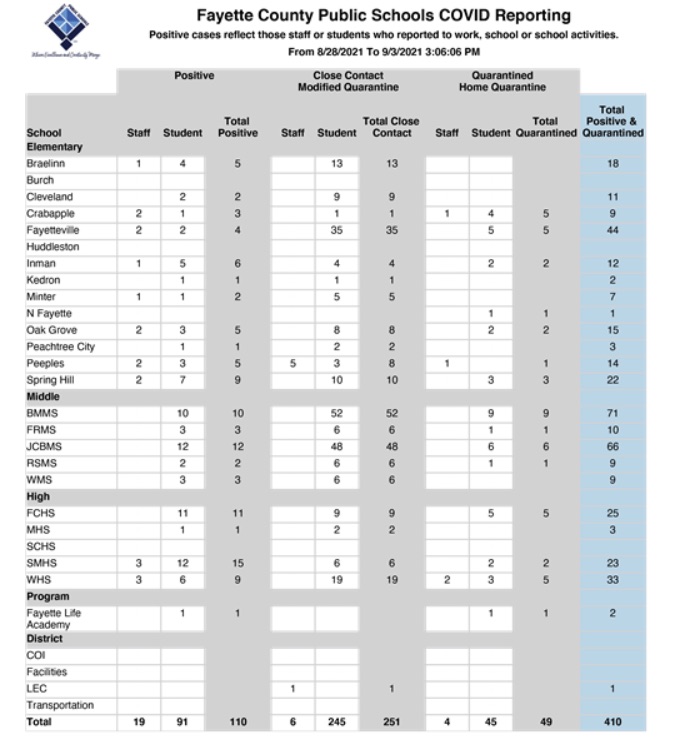New Covid-19 cases fell by 36% in Fayette County public schools last week compared to the previous week, from 174 down to 110, according to the Sept. 3 school system report.
Classroom quarantines now are figured in 2 categories — close contact modified quarantine and the outright home quarantine — and that total decreased slightly.
Students cases last week were spread evenly across elementary, middle and high schools — 30 each plus one in Fayette Life Academy. Among teachers and staff, 13 elementary staffers and 6 high school staffers had new infections, while no middle school staff had any new cases.
Meanwhile, new infections of Fayette County residents hit a pandemic high just as August was ending, but the graph by weekend at least temporarily appeared to be headed downward.

The graph of confirmed infections, as reported by the Georgia Department of Public Health, shows the peak was a 7-day moving average of 61.6 cases on Aug. 28 and 87 confirmed cases that day. By Sept. 2, the 7-day moving average had declined to 57 with 51 confirmed cases reported on that date, DPH data showed.
Fayette County leads the state in Covid vaccinations at 56% fully vaccinated, DPH reported Friday. The county also has the lowest per capita infection rate of all 159 Georgia counties, at 10,287 infections per 100,000 residents, according to msn.com.
Tabulation of DPH data for the past 9 days — since Sunday, Aug. 29 — shows Fayette has recorded 433 new infections, or about 48 per day. During the same period, 33 Fayette residents have been admitted to hospitals to treat Covid symptoms, to bring the pandemic total to 423 hospitalizations. At the same time, Fayette now has reported 172 Covid-related fatalities for a death rate of just under 2% of confirmed cases.
Dph issued a news release last week when statewide Covid fatalities topped 20,000 on Sept. 3:
“It is tragic but not surprising that we have surpassed this grim milestone of 20,000 Covid deaths in our state,” said Kathleen E. Toomey, M.D., M.P.H., Georgia Department of Public Health commissioner. “Ninety seven percent of Covid deaths since we’ve had vaccine are in unvaccinated individuals. These deaths are preventable.”
Covid vaccines are safe and effective at protecting against Covid-19 infections. Covid vaccines also help prevent severe illness and death if an individual does get sick. The vaccines also reduce the risk of people spreading the virus that causes Covid-19.
Covid cases are surging in Georgia, driven by the delta variant. The delta variant is more transmissible than the original SARS-CoV-2 and research shows that it results in a higher rate of severe illness and hospitalization than other variants. Covid-19 is spreading fastest in areas with low vaccination rates. Currently, only 44% of Georgians are fully vaccinated.
All Georgians aged 12 and older are urged to get vaccinated, wear a mask in public settings and wash their hands frequently.
Covid vaccine is available statewide and is our best tool for ending this pandemic and reducing the overwhelming strain on EMS, the healthcare system and healthcare providers. To find a Covid vaccination location, log on to https://dph.georgia.gov/Covid-vaccine.
Covid testing is recommended immediately for anyone experiencing symptoms of Covid-19. Additionally, individuals who have had a known exposure to someone with suspected or confirmed Covid-19 should be tested, even if they are fully vaccinated.
People who are fully vaccinated should get tested 3-5 days after exposure. Unvaccinated individuals should quarantine and be tested immediately after being identified, and, if negative, tested again in 5–7 days after last exposure.
To find testing locations, log on to https://dph.georgia.gov/Covidtesting. Please do not go to hospital emergency rooms for Covid testing.
For updates on Covid-19, follow @GaDPH and @GovKemp on Twitter and @GaDPH and @GovKemp on Facebook.
Below is the statewide medical facility patient census, showing a new pandemic peak of 5,952 patients, 35.5% of all patients in the state’s hospitals.







